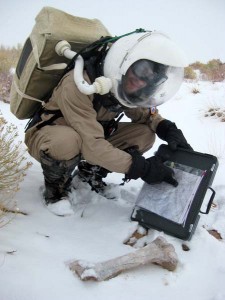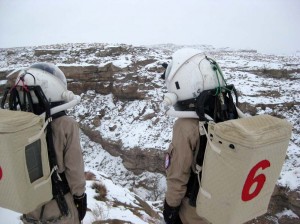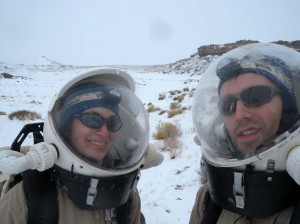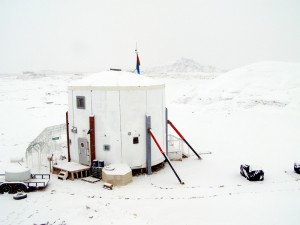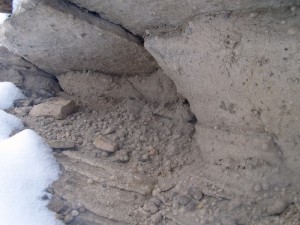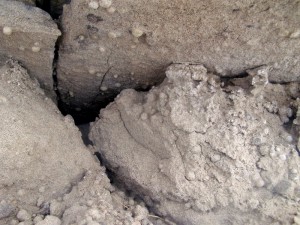Although today’s snow unfortunately canceled all ATV related EVAs, Luis happily suggested a biology related pedestrian EVA. Brian, Luis and I set out in the early afternoon with nominal EVA gear, headlamps to see each other better in the snow conditions, and Luis’ biology sampling kit. Our destination was Candor Chasma, which is approximately 2.5 km east of the Hab module.
We all eagerly suited up and set out on our journey, but upon opening the airlock door and stepping into the white tundra, we soon realized that sunglasses were a must on this EVA due to the glare off the snow, and unfortunately not all of us were wearing them. Perhaps the shortest EVA in history, our only accomplishment was to knock snow off the satellite receiver and restore Internet access for the Hab. We then sadly returned to the Hab, going through the ingress procedures, and obtained our shades from HabCom. Lesson learned for snow EVAs is to prepare for the glare!
Once again, we were out the hatch in no time bounding through the snow towards the east. Walking in the snow was a bit more challenging in the suits since you cannot determine the depth of the terrain below. It was also slippery and a few of us fell, careful to save the backpack and helmet, sacrificing our lower bodies. Along the journey were several majestic steppes and striated slopes sprinkled in snow. Luis was quick to find two large femur bones (possibly from a cow) during our walk, and also took samples of the fresh snow for biological testing. We walked at an intense pace and after an hour arrived at Candor Chasma, a mini Grand Canyon filled with multi-colors and striations in the sheer cliff. The view was amazing, however, both Brian’s and my visors were starting to fog, and it began to get exponentially worse. We had all used defogger for the visors, but today’s temperatures were lower than on previous days. We made the decision to turn around and head for the Hab, and the situation became alarmingly worse. I had about 10% visibility out of the lower right part of the helmet, and had to walk with my head to the side to see anything in front. I felt like I was blindfolded and walking to a piñata on the bed of a moving truck. Neither Brian nor I could wipe the fog with our caps since we were both wearing the headlamps for safety. After several efforts to stay in sim, including trying to warm the outside of the helmet with our gloves to get the inside fog to evaporate, we had to opt for safety. After having stumbled half the way back to the Hab, it was necessary for me to break sim and take the helmet off. Once I had vision, I watched out for Brian, who miraculously remained in sim with 0% visibility by the time we were home. We relayed terrain information and directions to him over the radios. In the future, I’d like to do an emergency EVA where this situation would result in us roping ourselves together, walking with one arm on the others’ shoulder, or calling for help from the Hab crew. With two out of the three of us visually impaired, we certainly would have called for help from our fellow crewmembers back at the Hab.The 2.5 hours of intense exercise was a welcome challenge for the three of us, having been cooped up a bit inside, but the best reward was the hot cocoa awaiting us upon our return.
